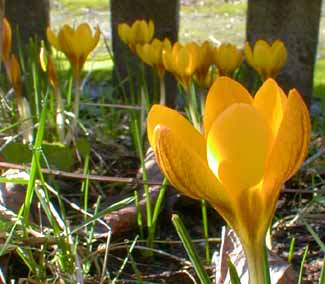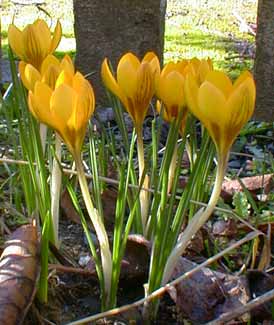 'Goldilocks'
'Goldilocks'
Yellow Snow Crocus
Just a little crocus
Growing in the grass
Can announce the springtime
To the folks that pass.
-Alice Crowell Hoffman,
"Crocus Children"
"Crocus Children"
This long-naturalized drift I have identified, with fingers crossed, as Crocus chrysanthus 'Goldilocks.' It has been many years in the garden, & either Granny Artemis stuck them in the ground the first year we lived here, or they were already planted by the previous owners; we've forgotten.
They grow along a six-foot-wide two-foot-deep area, interrupted along their width by smaller drifts of other crocuses, such as the white C. c. 'Snow Bunting,' & C. c. 'Blue Pearl,' both of which begin blooming a week to two week after 'Goldilocks.'
 This crocus is canary yellow with bronzy-violet markings low on the outer petals. It resembles, & blooms almost simultaneously with (or starting a week after), the slightly paler (but still brilliantly yellow) magenta-streaked C. c. 'Fuscotinctus,' & the even paler magenta-streaked C. c.'Gypsy Girl.'
This crocus is canary yellow with bronzy-violet markings low on the outer petals. It resembles, & blooms almost simultaneously with (or starting a week after), the slightly paler (but still brilliantly yellow) magenta-streaked C. c. 'Fuscotinctus,' & the even paler magenta-streaked C. c.'Gypsy Girl.'The yellow varieties of C. chrysanthus, being closest to the color of the wild forms from Asia Minor, are the earliest to appear in the garden as winter nears its end, followed closely by whites & blues & purples.
"Goldilocks" is very striking most of February then begins to fade out & vanish early in March, but other snow crocuses in other colors are quick to take their place, including the last-blooming yellow one we have, Crocus x luteus 'Stellaris' which takes over one corner of the same general area in March when 'Goldilocks' is done, extending the presence of yellow when purples & blues might otherwise predominate.
'Goldilocks' was released in 1950 from Barr & Sons, & has in the decades since remained one of the most standard offerings. That famous old London nursery was responsible for introducing many cultivars of so many types of plants, including such crocuses as C. tommasianus 'Barr's Purple,' & C. speciosus 'Oxonian.'
This drift is planted along the afternoon-sunny side of the Oyama magnolia against a picket fence. The Oyama is still leafless when the various crocuses are abloom, & many die-back perennials have not yet made their reappearance, so crocuses have all the space & sunlight to themselves. The area will be quite shady when the crocuses are gone, shrubs' & trees' deciduous leaves restored, & when perennials such as monkshoods & columbines leap forth.